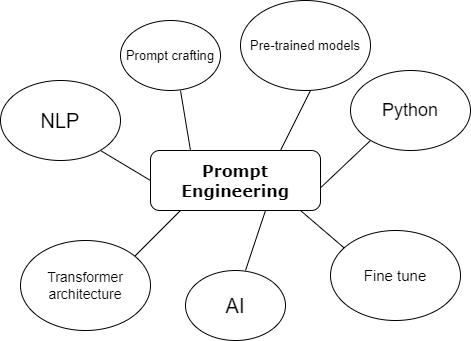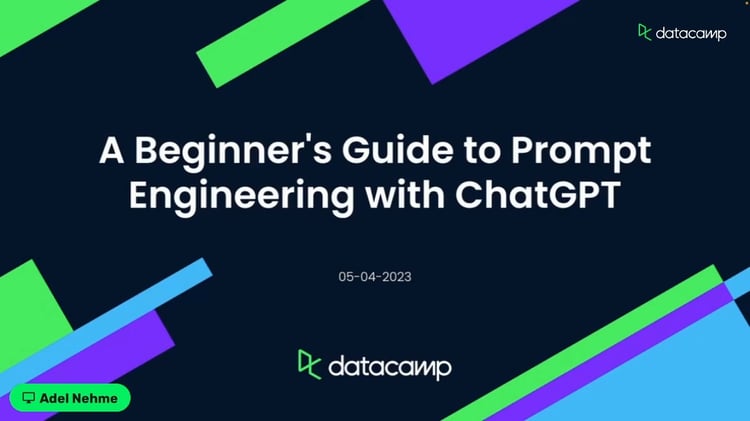Course
Generative AI has changed the way we interact with and think about artificial intelligence. With conversational AI such as ChatGPT and Anthropic's Claude, you just need to type in a few prompts into the tool and the AI model usually responds exactly with the information you’ve asked for. Now, the question is, who are the professionals creating these exceptional AI models?
ML engineers, AI engineers, data scientists, and, obviously, prompt engineers are always researching and bringing incredible AI abilities to the table. So, starting a career as a prompt engineer could be the next big thing, just as being a software developer was back in the early 2000s.
Whether you’re already a data professional or AI is your passion, this guide is for you. Throughout this article, we’ll detail step-by-step instructions on how to become a prompt engineer. Let’s dive in!
What Does a Prompt Engineer Do?
Any non-tech individual today can go to ChatGPT and ask for something they want. Then, why do we need prompt engineers? Well, prompt engineers know how to ask the AI model to generate accurate outcomes. They craft the right questions and create triggering prompts to make the model generate the best results.
Imagine you need Python code to develop a login page, so you might ask GPT something like: “Write a Python code to create a login page,” but someone who knows prompting phrase it as: “Act like a Python developer and show a junior developer how to create a login page that will have input fields for username and password, along with a login button.” That's the essence of the discipline, and you can learn more in our course, Understanding Prompt Engineering.
Prompt engineers also do a lot more technical aspects of dealing with large language models. They test and fine-tune AI models using prompts. The process involves tracking an AI model’s behavior by analyzing its responses to various prompts. Then, they look for patterns and biases, run A/B tests on the output data, and refine prompts to address limitations. Similarly, they have to understand the model's limitations and strengths, and iteratively improve prompts based on model responses.
Overall, prompt engineers are the key players in optimizing the entire AI prompt generation process for custom applications.
Prompt engineer responsibilities
Here is a summary of what a prompt engineer does in their day-to-day work:
- Craft effective prompts: Develop precise and contextually appropriate prompts to elicit the desired responses from AI models.
- Test AI behavior: Analyze how models respond to different prompts, identifying patterns, biases, or inconsistencies in the generated outputs.
- Refine and optimize prompts: Continuously improve prompts through iterative testing to enhance the accuracy and reliability of model responses.
- Perform A/B testing: Compare the effectiveness of different prompts and refine them based on user feedback and performance metrics.
- Document prompt frameworks: Create libraries of reusable, optimized prompts for specific use cases or industries.
- Collaborate with stakeholders: Work with developers, product teams, and clients to align AI-generated outputs with business or project objectives.
- Fine-tune AI models: Adjust pre-trained AI models to improve their behavior for specific applications, using tailored prompts during the training process.
- Ensure ethical AI use: Identify and mitigate biases in prompts and outputs to ensure fairness, inclusivity, and adherence to ethical guidelines.
- Train and educate users: Help end-users and teams understand best practices for interacting with AI models effectively.
Table: Comparison of Key Roles in AI
| Role | Core Responsibilities | Required Skills | Typical Tools/Technologies Used |
|---|---|---|---|
| ML Engineer | Develops machine learning models and deploys them into production. | Python, TensorFlow, PyTorch, Scikit-learn | TensorFlow, PyTorch, Kubernetes |
| AI Engineer | Designs and implements AI solutions, including models and systems. | Data structures, algorithms, AI frameworks | TensorFlow, Keras, OpenAI API |
| Data Scientist | Analyzes data to extract insights and builds predictive models. | Statistics, data visualization, machine learning | Pandas, NumPy, R, Python |
| Prompt Engineer | Crafts and refines prompts to optimize AI model outputs. | NLP, creative writing, understanding of LLMs | GPT, ChatGPT, LangChain |
How to Become a Prompt Engineer

Becoming a prompt engineer is a smart career move, especially as Gen AI is one of the fastest-growing technologies, expecting significant growth for the next ten years, with the industry expected to be worth $356.10bn by 2030. Here’s a deep dive on how to become an AI prompt engineer.
Learn the Fundamentals
1. Master Python
Prompt engineers would need a solid understanding of Python programming. Knowing how to code in Python allows you to learn NLP and deep learning models quickly.
As a prompt engineer, you may not build an entire language model by yourself. But some high-paying prompt engineering positions expect you to analyze the data generated by language models, and gain insights into it to make the model better. And when it comes to handling data, Python stands out.
Follow these steps to learn Python for prompt engineering:
- Learn syntax
- Explore NumPy, Pandas, Matplotlib, and Scikit-learn libraries
- Get hands-on with NLTK, spaCy, TextBlob, and other natural language libraries
- Practice data analysis
- Learn about machine learning models
- Practice Python coding
2. Understand the basics of AI
Begin your professional journey by familiarizing yourself with the technology you’re going to leverage. In this case, you should first understand what AI is and then explore its subfields. The basic idea behind artificial intelligence (AI) is quite fascinating - making machines behave intelligently and similarly to humans to perform specific tasks.
Machine learning, natural language processing, data science, deep learning, and many other subfields are part of this larger area of AI. First, have an overview of each of these technologies and know how they differ from each other.
Check out the resources below to learn AI fundamentals:
- AI Fundamentals Skill Track: Here you’ll learn basics of AI, LLMs like ChatGPT, Gen AI concepts, and an overview of Machine Learning.
- Understanding Artificial Intelligence Course: This covers AI in daily life, AI at work, organizations integrating AI, and generative AI models.
Large language models have a really strong relationship with deep learning and NLP. Although not all prompt engineers build an AI model from scratch, it is expected that they have strong NLP and deep learning skills to understand the language model they prompt.
3. Learn about NLP
Natural language processing is one of the hottest topics in AI at the moment. It lets computers read and interpret human languages. What’s even more is that it enables machines to generate human-like responses in natural language.
Plus, NLP helps you design triggering prompts that can shape an AI model to generate targeted outputs. So, as a prompt engineer, NLP is something you should master. Explore NLP libraries like NLTK, spaCy, and Transformers to get ready to handle language data.
You’ll want to start by mastering basic text processing and go deeper into techniques like tokenization, sentiment analysis, and text summarization.
Here are some of the best NLP related articles and courses:
- What is Natural Language Processing?
- Introduction to Natural Language Processing in Python
- Natural Language Processing Skill Track
4. Master deep learning and Transformer models
As you work to become a prompt engineer, you’ll often encounter large language models like GPT, Gemini, LLaMA 3, and more. These LLMs are nothing but scaled deep learning models designed to understand and generate natural language. To handle them effectively, you’ll need to have a solid grasp of deep learning concepts.
ChatGPT, for instance, is fed on over 175 billion neurons. To understand what these neurons are and how they are fed, you should first know the idea of neural networks, the backbone of many deep learning algorithms.
Next, you might know that the ‘T’ in GPT stands for ‘Transformer’. The popular large language models are built on the Transformer architecture, including ChatGPT.
Transformer architectures use what’s known as an “attention mechanism” – a technique to improve model accuracy by focusing only on the relevant parts of the input data. Studying these architectures will help you craft effective prompts.
Develop Practical Skills Development to Become a Prompt Engineer
While you don't necessarily need a degree to get into prompt engineering, you should have some practical experience in certain technical skills. Let’s explore the languages and techniques you need to excel in.
5. Hands-on with Pre-trained Models
Prompt engineers spend a considerable part of their time working with pre-trained models. In case you don’t know, pre-trained models are the base AI models that are extensively trained on tons of data. This is the very first step of building any large language model.
If you truly want to master prompt engineering, get familiar with existing pre-trained models such as GPT-4, Llama 3, Claude 3, and more. Input different prompts and study how they react. Understand their text generation capabilities and spot limitations.
Moreover, understand the parameters these models are trained on. At times, you’ll need to tune their hyperparameters to achieve specific results.
6. Fine-tuning for Custom Applications
Only a few companies can afford to train large language models from scratch. That’s why others bring you in as a prompt engineer, tasking you with fine-tuning the current pre-trained models for their custom applications.
For example, a pre-trained model may not be able to generate an HTML file according to your design requirements. But you can fine-tune it on UI and HTML-specific datasets to get desired outputs.
Overall, a prompt engineer should be able to fine-tune any pre-trained model for specific tasks. This can be done by feeding the pre-trained models with small and specific datasets.
Data preprocessing, hyperparameter tuning, and transfer learning are must-have skills to fine-tune a pre-trained model everything by yourself.
Remember, the depth of these technical skills varies based on the requirements of the position you’re applying for.
Usually, for entry-level roles, just NLP concepts and clever prompt crafting capabilities are enough to enter. However, a senior-level or high-paying gig might require more profound hands-on experience with NLP libraries, deep learning algorithms, and advanced prompting techniques.
Here are some of the comprehensive guides to help you learn fine-tuning:
- An Introductory Guide to Fine-Tuning LLMs
- Fine-tuning GPT-3 Using the OpenAI API and Python
- Fine-tuning LLaMA 2: A Step-by-Step Guide to Customizing the Large Language Model
- How to Fine Tune GPT 3.5: Unlocking AI's Full Potential
- FLAN-T5 Tutorial: Guide and Fine-Tuning
Prompt Engineering Techniques
Explore different prompting techniques and learn to be creative with your writing. Let’s see how you can be better at creating prompts.
7. Master Prompt Crafting
Language models produce results based on the inputs you give. If you can explain an AI model exactly what you want and tune it to produce desired outputs, that's it; you can call yourself a prompt engineer.
Writing clear prompts and improving existing prompts are two of the main jobs of prompt engineers. They have to draft questions and sentences that can steer an AI model towards relevant responses.
For this, you have to be good at writing, and a tip to write better prompts is to include context and instructions in them. However, to become a master in prompt engineering, you’ll need to learn some advanced prompt engineering techniques, as we go through in the next section.
8. Advanced prompting techniques
We’ve already mentioned you to experiment with pre-trained models, and it’s a point that bears repeating. Use DALL-E, GPT-2, GPT-3, or BERT to practice different prompting techniques and see how they behave.
There are various strategies for model prompting such as zero-short prompting, one-shot prompting, iterative prompting, and many more. You can learn and practice these prompting techniques to become an exceptional prompt engineer.
To not miss out on anything, learn about LangChain. We’ve got a full guide covering LangChain for prompt engineers, but for a quick overview, LangChain is a framework for maximizing the accuracy and relevance of the model outputs.
| Technique | Description |
|---|---|
| Zero-shot Prompting | The model is asked to generate a response without any prior example or context. |
| One-shot Prompting | The model is given one example along with the task prompt to guide the response generation. |
| Iterative Prompting | Involves refining prompts based on previous outputs to gradually improve the model's responses. |
| Chain of Thought | Encourages the model to explain its reasoning step-by-step, improving reasoning and accuracy. |
Career Advancement and Real-world Application
While having a degree in a relevant computer science or engineering field is a plus, it isn’t the only route. You can become a prompt engineer without a degree by completing certification courses, working on real-world projects, and continuous learning. Let's delve into each step to shape your career in prompt engineering.
9. Real-world projects and portfolio building
With a clear idea of AI technology and the skills above, you can start applying your new expertise to real-world projects. Whether you’re a working professional or a university student, volunteer for projects that need prompt engineering.
Here are some of the great AI projects you can start building:
- 7 AI Projects for All Levels
- 5 Projects You Can Build with Generative AI Models
- 7 NLP Projects for All Levels
If your project uses a pre-trained model, have a technical understanding of how it’s built and how it behaves. Try out different ways of asking the model to do things and see how it responds. Use the advanced prompting techniques you’ve learned to trigger the model. This way, you can turn your theory into skills.
As you go, you can join in conversational AI and LLM-related competitions on Platforms like Kaggle to see where you stand among your peers. Remember, everything you do in this step can go into your portfolio, making your profile even stronger.
Having a professional portfolio is crucial at any stage of your career. Datacamp has an easy editing portfolio builder with beautiful pre-made templates. So, leverage this free portfolio builder to showcase your skills, experience, projects, and interests in an attractive way.
10. Keep Learning & Engage with the AI Community
Take online courses; there are a lot of prompt engineering courses that have been added recently. Certification courses not only help you acquire skills but also add evidence to your profile that you actually learned the technology.
It’s necessary to stay current with the latest trends, especially in booming tech like OpenAI's Sora. There is no better way to stay updated than engaging with the right community. For this, follow top prompt engineering researchers and developers on sites like LinkedIn, Medium, and Twitter.
Conclusion
Now is the right time to get started with Gen AI. The world of tech companies is looking for prompt engineers more than ever to implement conversational AI in their businesses.
The path to becoming an AI prompt engineer is both rewarding and exciting. Anyone can become a prompt engineer with the right combination of the technical and non-technical skills mentioned throughout this article.
If you’re serious about your career in prompt engineering, explore the following courses from Datacamp:
Srujana is a freelance tech writer with the four-year degree in Computer Science. Writing about various topics, including data science, cloud computing, development, programming, security, and many others comes naturally to her. She has a love for classic literature and exploring new destinations.





